|
Potted Blackberry Bushes For Sale
|
|
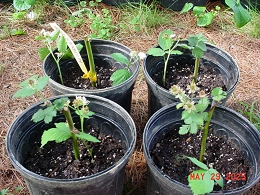
Arapaho Blackberry
|
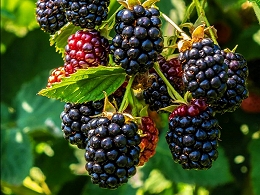
Black Satin Blackberry
|
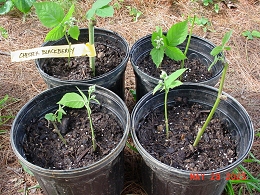
Chester Blackberry
|
Blackberry Bushes
All of our potted Arapaho, Black Satin, and Chester blackberry bushes are started from cuttings or suckers off our blackberry bushes growing on our property and are ready for transplant.
A potted blackberry bush can be transplanted into the ground almost any time of the year since their root system is barely disturbed with little or no stress when transplanted from a pot. Transplant these blackberry bushes tomorrow or grow these blackberry bushes in the existing pot for up to one year.
Blackberries offer a variety of health benefits due to their high content of fiber, vitamins, and antioxidants very similar to blueberries, strawberries, and raspberries.
Grow an abundance of blackberries and freeze plenty to enjoy throughout the year. It is easy to freeze blackberries and they are just as tasty and beneficial as freshly picked blackberries.
In times of need, a neighbor growing blackberries may be a friend indeed!
|
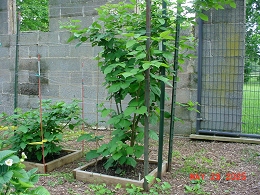
Arapaho Blackberry
|

Black Satin Blackberry
|
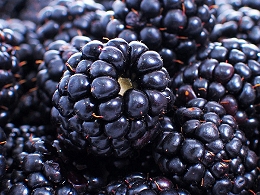
Chester Blackberry
|
'Arapaho' Thornless Blackberry (Rubus fruticosus)
|

Arapaho Blackberry
|
The first blackberries of the season are eagerly anticipated-and that's why blackberry growers treasure Arapaho Thornless Blackberry plant. It is one of the earliest ripening blackberry plants, producing fruits in early to mid June. The large one inch berries are firm, with good flavor and small seeds-so it's a good choice for making jam.
The berries are also delicious for eating fresh or cooked into pies and cobblers. The fully erect, disease resistant canes grow 5-8 ft. tall and are thornless, so picking is easy.
The Arapaho blackberry is an erect, early-ripening, thornless shrub that produces large red and black fruit. The berries are firm and tasty with small seeds - good for making jams and syrups. And there is no need for a trellis, as this plant is self-supporting. Although a trellis is always a good idea, there is no need for a trellis or support. Mature plants can produce up to 8-10 quarts of berries.
'Black Satin' Thornless Blackberry (Rubus fruticosus)
|
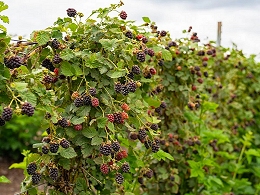
Black Satin Blackberry
|
The Black Satin Thornless Blackberry are known for their extra-large fruit that can grow as big as golf balls. Their ultra-hardy texture make up these thornless semi-erect plants during midsummer months. The smooth, glossy exterior covers the superbly sweet fruits that produce no sour bite.
Easy to grow and sure to delight, the Black Satin Thornless Blackberry shrub produces delicious, fruitful harvests. Black Satin Blackberry vines are thornless, making the nimble fingers (kid and adult alike) that pick them unharmed. Growing at a moderate to fast pace, it produces ample dark blackberries which you can collect and eat raw, make into jams, or bake into pies. Thriving in the warm conditions, an individual mature plant can provide in excess of 10 pounds of berries-enough to feed your family for months to come!
In addition to its tasty, fruit-producing properties, the Black Satin Thornless Blackberry is also notably hardy and low-maintenance. It is very disease resistant and suitable in high temperatures. Although it prefers full sun, it can also tolerate some shade, and its smaller size means it won't be overbearing in your yard. Add this bush to garden, walkways, entrances and borders or containers on your patio.
'Chester' Thornless Blackberry (Rubus fruticosus)
|

Chester Blackberry
|
The hardiest of the thornless blackberries, Chester Blackberry also bears the largest fruit. The semi-upright branches will be loaded with sweet, deep blackberries in July. This fruit is perfect for eating fresh or baked as pies and cobblers. Blackberries are easy to grow and will have a bumper crop of fruit. These edible plants need to be in full sun (5-6 hours) and take bear fruit after the first year of growth.
The Chester Thornless Blackberry is self-pollinating usually bearing fruit in their first year, and the blackberries are typically ready to harvest as soon as July or early August. They are known for their high yield and can produce large, sweet, and juicy blackberries in mid-summer, usually harvested from mid-July to early September.
Blackberry Health Benefits
Blackberries offer numerous health benefits due to their high content of antioxidants, fiber, vitamins and minerals, potentially supporting heart health, digestion, and immunity. Blackberries are low in calories, carbs, and fat. They might even fight cancer and help prevent heart disease. The blackberry leaves can be used to make a surprisingly delicious health beneficial tea. Rich in antioxidants, blackberries are packed with antioxidants, including anthocyanins, which are known for their anti-inflammatory and anti-microbial properties.
Antioxidant Power: Blackberries are rich in antioxidants, including anthocyanins, which protect cells from damage caused by free radicals. This may help reduce the risk of chronic diseases such as cancer and heart disease.
Fiber Content: Blackberries are an excellent source of fiber, which promotes healthy digestion and helps regulate blood sugar levels.
Vitamin and Mineral Rich: Blackberries are a good source of vitamins C, K, and E, as well as minerals like manganese and magnesium. These nutrients support immune function, bone health, and overall well-being.
Weight Management: Blackberries are low in calories and fat, making them a filling and healthy snack that can aid in weight management.
Anti-Inflammatory Properties: The anthocyanins in blackberries have anti-inflammatory effects, which may help reduce pain and swelling associated with conditions like arthritis.
Improved Heart Health: Blackberries' fiber, antioxidants, and vitamin K contribute to maintaining a healthy cardiovascular system by lowering cholesterol and blood pressure.
Cognitive Function: Studies suggest that blackberries may improve cognitive function and protect against age-related brain decline due to their antioxidant content.
Blackberries may also have the following benefits: Support healthy skin and hair, Enhance wound healing, Boost immunity, and Protect against infections.
How To Prune Blackberry Bushes
To properly prune blackberry bushes, you need to distinguish between primocane and floricanes. Summer-bearing blackberry canes (floricanes) should be pruned in late winter/early spring, removing diseased or damaged canes and shortening lateral branches. In summer, cut off the tips of new primocanes when they reach 36 inches. After fruiting, remove the spent floricanes. Primocane-bearing blackberry canes should be pruned in late winter/early spring, cutting all canes back to ground level.
Understanding Blackberry Cane Types: Primocanes are new canes that will fruit in the current year. Floricanes are the older canes that produced fruit the previous year and will not fruit again.
Pruning Summer-Bearing (Floricane) Blackberries: Late winter/early spring remove any dead, diseased, or damaged canes. Shorten lateral (side) branches to 12-15 inches to encourage larger fruit. Summer when new primocanes reach 36 inches, tip them (pinch off the tip or cut it off). This encourages lateral growth and increased fruiting surface. After Harvest remove all fruited (floricanes) at the ground level.
Pruning Primocane-Bearing Blackberries: Late winter/early spring cut all canes back to ground level. No further pruning is needed.
General Tips: Use sharp, clean pruning tools to help prevent disease spread. Wear gloves because blackberry thorns can be quite painful. Remove pruned material to prevent disease spread, discard the pruned canes. Be patient as blackberry plants can take a few years to reach their full fruiting potential.
|